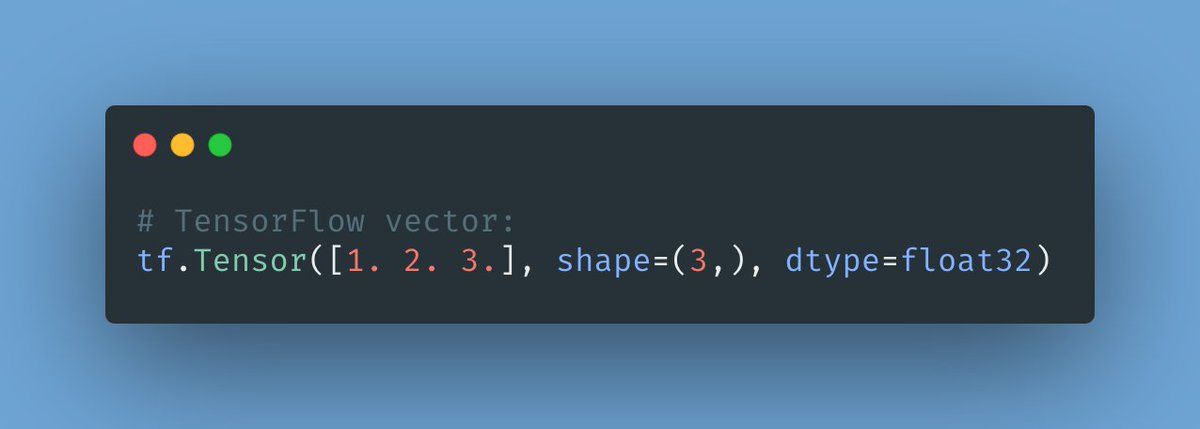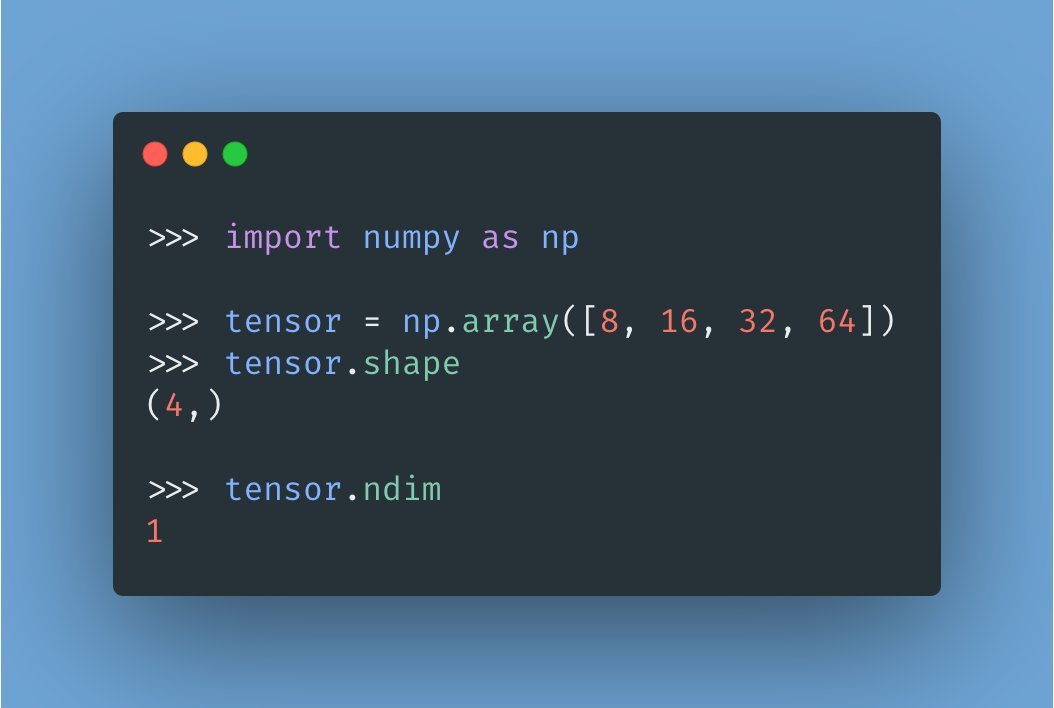
A 13-tweet introduction to one of the most basic structures used in machine learning: a tensor.
Understanding how tensors work is fundamental. They aren't complex but working with them may get confusing if you don't understand all the pieces.
Let's solve that today.
↓ 1/13
Understanding how tensors work is fundamental. They aren't complex but working with them may get confusing if you don't understand all the pieces.
Let's solve that today.
↓ 1/13
Three primary attributes define a tensor:
• Rank: Number of axes.
• Shape: Number of dimensions per axis.
• Data type: Type of data contained in it.
↓ 2/13
• Rank: Number of axes.
• Shape: Number of dimensions per axis.
• Data type: Type of data contained in it.
↓ 2/13

The rank of a tensor refers to the tensor's number of axes.
Examples:
• Rank of a matrix is 2.
• Rank of a vector is 1.
• Rank of a scalar is 0.
↓ 3/13
Examples:
• Rank of a matrix is 2.
• Rank of a vector is 1.
• Rank of a scalar is 0.
↓ 3/13
The shape of a tensor describes the number of dimensions along each axis.
Examples:
• () scalar
• (2,) vector
• (3, 2) matrix
• (3, 2, 5) 3D tensor
↓ 4/13

Examples:
• () scalar
• (2,) vector
• (3, 2) matrix
• (3, 2, 5) 3D tensor
↓ 4/13


The data type of a tensor refers to the type of data contained in it.
For example, here are some of the supported data types that we could store in a tensor:
• float32
• float64
• uint8
• int32
• int64
↓ 5/13
For example, here are some of the supported data types that we could store in a tensor:
• float32
• float64
• uint8
• int32
• int64
↓ 5/13
A scalar—or 0D tensor—has rank 0 and contains a single number. These are also called "0-dimensional tensors."
The attached image shows how to construct a 0D tensor using NumPy. Notice its shape and its rank (.ndim attribute.)
↓ 6/13
The attached image shows how to construct a 0D tensor using NumPy. Notice its shape and its rank (.ndim attribute.)
↓ 6/13

A vector—or 1D tensor—has rank 1 and represents an array of numbers.
The attached image shows a vector with shape (4, ). Notice how its rank (.ndim attribute) is 1.
↓ 7/13
The attached image shows a vector with shape (4, ). Notice how its rank (.ndim attribute) is 1.
↓ 7/13

A matrix—or 2D tensor—has rank 2 and represents an array of vectors. The two axes of a matrix are usually referred to as "rows" and "columns."
The attached image shows a matrix with shape (3, 4).
↓ 8/13
The attached image shows a matrix with shape (3, 4).
↓ 8/13

You can obtain higher-dimensional tensors (3D, 4D, etc.) by packing lower-dimensional tensors in an array.
For example, packing a 2D tensor in an array gives you a 3D tensor. Packing this one in another array gives you a 4D tensor, and so on.
↓ 9/13
For example, packing a 2D tensor in an array gives you a 3D tensor. Packing this one in another array gives you a 4D tensor, and so on.
↓ 9/13

Some common tensor representations in practice:
• Vectors - 1D: (features)
• Sequences - 2D: (timesteps, features)
• Images - 3D: (height, width, channels)
• Videos - 4D: (frames, height, width, channels)
↓ 10/13
• Vectors - 1D: (features)
• Sequences - 2D: (timesteps, features)
• Images - 3D: (height, width, channels)
• Videos - 4D: (frames, height, width, channels)
↓ 10/13
Machine learning algorithms deal with a subset of data at a time. We call these "batches."
When using a batch, the tensor's first axis is reserved for the size of the batch. This adds another axis to the representations we saw before.
↓ 11/13
When using a batch, the tensor's first axis is reserved for the size of the batch. This adds another axis to the representations we saw before.
↓ 11/13
For example, if your handling 2D tensors (matrices), a batch of them will have a total of 3 dimensions:
(samples, rows, columns)
Notice how the first axis is the number of matrices that you have in the batch.
↓ 12/13
(samples, rows, columns)
Notice how the first axis is the number of matrices that you have in the batch.
↓ 12/13
Following the same logic, a batch of images can be represented as a 4D tensor and a batch of videos as a 5D tensor:
• (samples, height, width, channels)
• (samples, frames, height, width, channels)
↓ 13/13
• (samples, height, width, channels)
• (samples, frames, height, width, channels)
↓ 13/13
If you found this thread helpful, follow me @svpino for weekly posts touching on machine learning and how to use it to build real-life systems.
It’s all about building value, and that’s way more fun if we do it together.
It’s all about building value, and that’s way more fun if we do it together.
• • •
Missing some Tweet in this thread? You can try to
force a refresh






